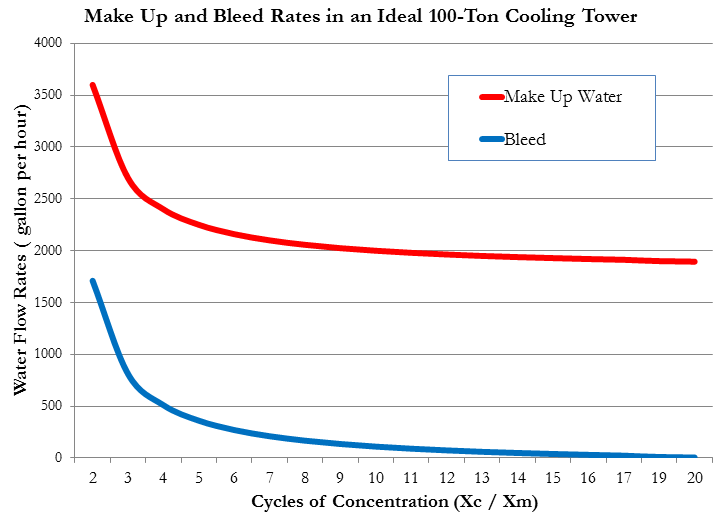Blowdown in Cooling Tower
Published on by Asanka Wimalarathne, Director at Asia Green Solutions in Technology
Hi Good Morning Everyone,
As per the water TDS, the COC (Cycle of Concentration) of the cooling tower is about 8. But the plant engineer is mentioning the blowdown rate is zero. How this can be possible?
Taxonomy
- Treatment
- Total Dissolved solids
- Technology
- Cooling tower maintenance and repairs
14 Answers
-
Modern drift eliminators are typically rated between 0.005% (cross-flow design) and 0.001% (counter-flow design) of recirculation rate. If an operating system does not include automated blowdown (not recommended), cycles of concentration could be limited by deposition/scaling, side-stream filtration/separators, intermittent overflow during idle periods, process leaks, etc. Detailed makeup and recirculating water analyses would allow an ion mass balance. Compare conductivity, calcium, sodium, and silica cycles to see how closely they align.
1 Comment
-
I run silica cycles, along with total hardness and chloride cycles, however, there are certain difficulties with getting "perfect" data on the silica cycles, as the make-up silica at our plant varies considerably from day to day. I have heard reports of utilizing high-efficiency soft water plant, while retaining the silica in the water, and simply closing the blow-down, to arrive at ~100 cycles of concentration. BTW, drift solids are reduced even further when there is sufficient dissolved solids in the water such that making a PM10 particle is completely impossible.
-
-
Theoretically a zero blow down program is possible, but not at 8 cycles. There must be water loss from either drift or leaks. See the graph attached. It's not until around 20 COC, the blow down requirement is nearly zero

-
Instead of blowing down the tower, consider using an electronic water treatment system like HydroFLOW to clean the water. (www.hydroflow-se.com) The low power, high-frequency decaying signal generated by HydroFLOW is induced into the water stream and travels throughout the hot, chilled or condenser water systems. The electrical signal prevents and removes scale, biofilm, & bacteria from system surfaces while adding a film of magnetite that protects the ferrous parts of the system from corrosion. Include an air & dirt separator with SweepCLEAR to physically remove 99% of the entrained dirt (scale, rust) and air water. www.sweepclear.com . Clean water does not have to be blown down.
-
Hello,The COC is 8 is very high it means no blowdown.It is maximum efficiency and no wastage of water..Cycles of concentration (or cycles) is a comparison of dissolved solids level
of the blowdown with the makeup water. This can be expressed as:
Cycles of concentration can also be expressed as:
Makeup = Evaporation + Blowdown + Process Leaks + Windage + Drift
Makeup = Evaporation + Blowdown
Cycles is Evap +BD/BD -
If the COC is correct, it would imply high drift and other water losses.
-
If the plant is intermittently used, when plant operation stops, water drains back to the tower and is lost through the overflow. This can act as a bleed even though it occurs only once a day and controls the cycles of concentration.
-
Very well explained by everyone. What is your make up water consumption?
Makeup = Evaporation + Blowdown + Process Leaks + Windage + Drift
Evaporation loss is about 1% of circulation water. Windage + drift are about 0.2-0.3%. Rest all is your water lost via abnormal leaks in your system. That is your blow down water getting lost from the system in an unconventional manner without your doing physical blow down.
-
Take a know amount of a dye whose concentration you can accurately measure. add this to the tower deck. Take an estimate of the system volume and using the recirculation rate determine what 3 turnover rates would be. Wait that long and take a dye reading. That is your zero point.
Take readings every 2 hours for 8hours. You can now plot those concentration drops and determine the rate of loss from the system. That will equal your water loss or bleed. Remember Bleed is water loss and blowdown is what you do intentionally.
Evaporation/[cycles -1] = Bleed Bleed = drift + leaks + blowdown
-
As others have indicated, drift and system leaks often go unmeasured but function as blowdown. Remember, use of TDS and/or other tests must take into account outside influences (such as process leaks adding TDS or treatment chemicals adding TDS, etc). If treatment is added (such as phosphate) you might be able to test for this compound in various sewers to isolate any leaks to a specific area in the facility.
-
For some cooling systems where the drift elimination is not efficient, the drift rate is significant enough to result in 8-10 cycles of concentration even when blow-down is zero.
Another source is process leaks, excessive sampling where the sample flow is to drain, etc.
-
Water from the tower is being lost elsewhere. System leaks, tower drift are typical examples. It would be possible, by calculation, to determine how much water is being lost. where it's being lost may be difficult to find.
-
what is the make up water characterization ?
-
At the beggining of operation COC is 1 and Blowdown is zero. If there is no Blowdown COC will raise continuously, with a speed depending on evaporation.
When we measure the Blowdown any water loos should be included and expressed as Blowdown. It is not fair to say thet Blowdown is only the water flowing from one specified valve.
-
Spray loss of the tower